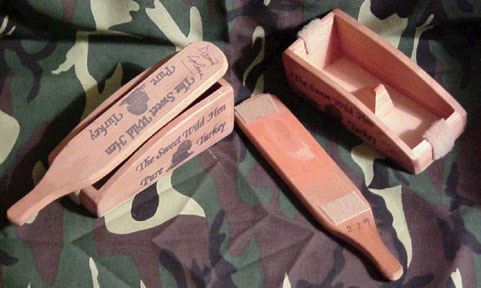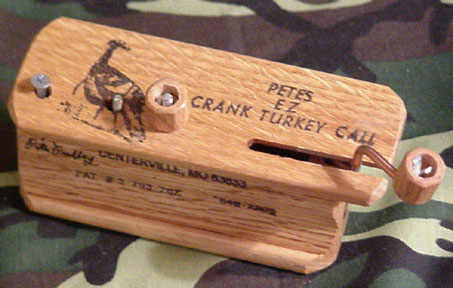
This call, made by Winky Hicks of Grove Hill, Alabama, looks like a box call but operates more like a push-button call (Mr. Hicks also makes push-button callers). Velcro at each end holds the lid to the sound chamber when not in use. To operate the call, the lid must be pushed across the sounding surface from front to back (as opposed to side-to-side as with box calls). I had the opportunity to try one of these once and they really sound good. A box call for. . .geese? This was in a recent edition of Waterfowl magazine. Two views of a (presumably) very old goose box call, made in San Francisco by M. J. Kochman. I am interested in finding out the history of goose box calls, and if anyone knows anything about them, or good sources of information, please let me know. Two limited edition NWTF calls made by Dale Rohm. Note the different engravings. The owner of the calls spoke with Mr. Rohm, who explained that he swtiched engravers after the first 1,000 calls were made, and the new engraver altered the design. The calls were purchased at two different NWTF banquets in 1999. Era/Raymond Chisholm call and Ben Lee Super Hen (right). The sounding strip in the trough of the Chisholm call is aluminum, while the strip in the Lee call is slate. Ben Lee sold the Super Hen in two models, one with an aluminum strip and one with slate. Era Chisholm was the widow of Raymond Chisholm, from Laurel, Mississippi. Mr. Chisholm first made this type of call which was later copied and mass-produced as the Super Hen. The strip in the trough of the call is aluminum, although slate can also be used. Mrs. Chisholm started making the calls after her husband passed away; she has since passed away as well. Pete Pulley call. P.S. Olt had a crank call out (below) similar to this at one time, and they made it under Mr. Pulley's patent and paid him royalties. Pete is from Centerville, MO. This is the P.S. Olt CT-220 Crank Turkey Call that was based on the Pulley call (above). Olt discontinued production of this call in 1979.












